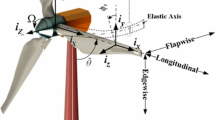Abstract
This study involves the unsteady analysis of the aerodynamic characteristics and the extraction of stability derivatives of an aerostat. The analysis of the effect of oscillations of the aerostat with respect to the wind variation is necessary for the model development and control of such a system. An unsteady analysis of the aerostat is presented in the current study. The combination of unsteady wind and unsteady motion of the aerostat is used for the analysis. Sinusoidal wind gust and sinusoidal oscillations along with the axial (surge) and vertical (heave) directions and about the pitch axis of the aerostat are considered. The aerostat model used for the current analysis is validated using experimental data available in the literature. The dynamic mesh feature used for the heave and surge oscillations and the mesh motion feature used for the pitching oscillation are validated using the NACA 0012 airfoil experimental data. The effect of phase shift between the wind gust and the aerostat motion, wind gust amplitude, angle of attack, and wind gust duration on the aerodynamic characteristics of the aerostat is studied. The stability derivatives of the aerostat are extracted using CFD simulations. The methodology used for the stability derivatives extraction is validated using experimental data of a prolate spheroid. From the results, the drag response is maximum for the 180-degree phase shift and the lift and moment responses have a lagging response for their 0-degree phase shift. Aerostat response is linear for gust amplitude variation, and drag response is less affected by the change in angle of attack. Stability derivatives involved in the longitudinal motion of the aerostat are extracted.






























Similar content being viewed by others
References
Somasundaran N, Kayani V, Chandrasekhar R, Kottayil SK (2019) Automated dispatch of wind power on microgrid for voltage regulation. Int J Autom Smart Technol 9(3):115–120. https://doi.org/10.5875/ausmt.v9i3.1912
Sengar S, Liu X (2020) Ensemble approach for short term load forecasting in wind energy system using hybrid algorithm. J Ambient Intell Humanized Comput. https://doi.org/10.1007/s12652-020-01866-7
Vanitha V, Raphel D, Resmi R (2019) Forecasting of wind power using variational mode decomposition-adaptive neuro fuzzy inference system. In: Innovations in Power and Advanced Computing Technologies (i-PACT), vol. 1, pp. 1–4. https://doi.org/10.1109/i-PACT44901.2019.8960017. IEEE
Azad A, Alam M, Uddin SA (2012) Analysis of wind gust distribution for power grid towers and wind turbine tower: an atmospheric hazard. Int J Adv Renew Energy Res (IJARER) 1:48–55
Khoury GA (2012) Airship technology. Cambridge University Press, Cambridge
Satapathy J, Bhat G (2020) Studies of extreme gust storm events in Bengaluru. India Curr Sci 119(2):343–351
Schmidt G (1997) Results of the 420K tethered aerostat flight tests. In: 12th lighter-than-air systems technology conference. https://doi.org/10.2514/6.1997-1420
Deodhar N, Bafandeh A, Deese J, Smith B, Muyimbwa T, Vermillion C, Tkacik P (2017) Laboratory-scale flight characterization of a multitethered aerostat for wind energy generation. AIAA J 55(6):1823–1832. https://doi.org/10.2514/1.J054407
Tureaud T, Smith N, Tureaud T, Smith N (1997) Wind tunnel characterization of a scaled class IV aerostat. In: 12th lighter-than-air systems technology conference. https://doi.org/10.2514/6.1997-1487
DeLaurier J (1977) Prediction of tethered-aerostat response to atmospheric turbulence. J Aircr 14(4):407–409. https://doi.org/10.2514/3.44602
Jones SP, Krausman JA (1982) Nonlinear dynamic simulation of a tethered aerostat. J Aircr 19(8):679–686. https://doi.org/10.2514/3.57449
Rajani A, Pant RS, Sudhakar K (2010) Dynamic stability analysis of a tethered aerostat. J Aircr 47(5):1531–1538. https://doi.org/10.2514/1.47010
Anoop S, Oruganti VRM (2020) Modelling and simulation of aerodynamic parameters of an airship. Adv Sci Technol Eng Syst J 5(4):167–176. https://doi.org/10.25046/aj050420
Wang X-L (2012) Computational fluid dynamics predictions of stability derivatives for airship. J Aircr 49(3):933–940. https://doi.org/10.2514/1.C031634
Huh L, Park Y-M, Chang B-H, Lee Y-G (2006) Aerodynamic design of the KARI mid-sized aerostat. Int J Aeronaut Space Sci 7(1):43–53. https://doi.org/10.5139/IJASS.2006.7.1.043
BADESHA S (1993) Aerodynamics of the TCOM 71M aerostat. In: 10th lighter-than-air systems technology conference. https://doi.org/10.2514/6.1993-4036
Kale S, Joshi P, Pant R (2005) A generic methodology for determination of drag coefficient of an aerostat envelope using CFD. In: AIAA 5th ATIO and 16th Lighter-Than-Air Sys Tech. and Balloon Systems Conferences. https://doi.org/10.2514/6.2005-7442
Chan SC, Hunt JD, Shervington K (2013) Wind tunnel study of a large aerostat, CFD validation. In: AIAA lighter-than-air systems technology (LTA) conference. https://doi.org/10.2514/6.2013-1339
Mi L, Gottlieb O (2018) Stabilization of a multi-tethered lighter-than-air rigid-body sphere undergoing vortex-induced vibrations in uniform flow. Nonlinear Dyn. https://doi.org/10.1007/s11071-018-4264-4
Yu-feng C, Wu-jun C, Yan-li H, Da-xu Z (2015) Vibration characteristic analysis and experiment of non-rigid airship with suspended curtain. J Shanghai Jiaotong Univ (Sci). https://doi.org/10.1007/s12204-015-1620-0
Jietao S, Shaoping S, Hong P (2019) Control of active and passive vibration isolation stabilization platform of airship based on characteristic model. In: 2019 Chinese Control Conference (CCC), pp 2325–2330. https://doi.org/10.23919/ChiCC.2019.8866308
Anoop S, Velamati RK, Oruganti VRM (2021) Aerodynamic characteristics of an aerostat under unsteady wind gust conditions. Aerosp Sci Technol 113:106684. https://doi.org/10.1016/j.ast.2021.106684
Ping L, Gong-yi F, Li-jun Z, Xiao-liang W (2013) Aerodynamic characteristics of airship Zhiyuan-1. J Shanghai Jiaotong Univ (Sci) 18:679–687. https://doi.org/10.1007/s12204-013-1443-9
Ansys. Academic Research FLUENT, Release 20.2, Help System, Fluent Theory Manual; ANSYS, Inc.: Canonsburg, PA, USA. Guide (2020)
Report on first offshore LIDAR wind data (\(2^{nd}\) year) analysis, NIWE, MNRE - Govt. of India. Accessed: 2020-03-03 (2019)
Compendium of unsteady aerodynamic measurements. AGARD-R-702. Report (August, 1982)
Fatahian E, Lohrasbi Nichkoohi A, Salarian H, Khaleghinia J (2020) Effects of the hinge position and suction on flow separation and aerodynamic performance of the NACA 0012 airfoil. J Braz Soc Mech Sci Eng. https://doi.org/10.1007/s40430-020-2170-4
Korotkin A (2009) Added Masses of Ship Structures vol. 88. https://doi.org/10.1007/978-1-4020-9432-3
Acknowledgements
A part of the computations was performed on the Aziz Supercomputer at King Abdulaziz University’s High-Performance Computing Center (http://hpc.kau.edu.sa/). The authors acknowledge the computer time and technical support provided by the centre.
Author information
Authors and Affiliations
Corresponding author
Additional information
Technical Editor: André Cavalieri.
Publisher's Note
Springer Nature remains neutral with regard to jurisdictional claims in published maps and institutional affiliations.
Rights and permissions
About this article
Cite this article
Sasidharan, A., Velamati, R.K., Oruganti, V.R.M. et al. Computational analysis of the aerodynamic characteristics and stability derivatives of an aerostat under unsteady wind conditions. J Braz. Soc. Mech. Sci. Eng. 44, 225 (2022). https://doi.org/10.1007/s40430-022-03538-3
Received:
Accepted:
Published:
DOI: https://doi.org/10.1007/s40430-022-03538-3




